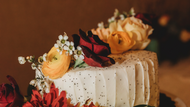Wedding Colour Palettes: How to Choose the Perfect Theme for Your Big Day
12th Mar 2025
Choosing the right colour palette is one of the most exciting parts of wedding planning. Your chosen colours set the tone for your entire celebration, influencing everything from invitations and floral arrangements to bridesmaid dresses and table décor. But with so many beautiful shades to choose from, how do you decide on the perfect wedding colour scheme?
In this guide, we’ll take you through everything you need to consider when picking your wedding colours, along with some trending and timeless palette ideas to inspire you.
1. Consider Your Wedding Season
The season in which you’re getting married can help guide your colour choices. Certain shades naturally complement the time of year and the seasonal elements available for decoration.
- Spring: Soft pastels like blush pink, lavender, mint green, and sky blue work beautifully with blooming flowers and fresh greenery.
- Summer: Vibrant hues such as coral, fuchsia, turquoise, and sunny yellow evoke a bright and lively atmosphere.
- Autumn: Rich, warm tones like burgundy, burnt orange, deep emerald, and mustard gold create a cosy, romantic feel.
- Winter: Elegant and sophisticated shades like deep navy, icy blue, forest green, silver, and classic red complement the season’s festive charm.
2. Let Your Venue Inspire You
Your wedding venue plays a key role in your colour choices. A grand ballroom might lend itself to a more formal colour scheme like gold and ivory, while a rustic barn setting may be better suited to earthy tones or boho-inspired hues.
- Outdoor venues (gardens, beaches, vineyards): Natural, soft hues like sage green, dusty blue, or peach work well.
- Historic buildings (manor houses, castles, cathedrals): Rich, regal tones like deep plum, navy, or emerald green can enhance the grandeur.
- Modern venues (lofts, art galleries, industrial spaces): Bold, contemporary colours like monochrome black & white or pops of bright hues can create a stylish aesthetic.
If your venue has strong existing colours (such as patterned carpets, coloured walls, or distinct architectural features), choose shades that complement rather than clash.
3. Think About the Mood You Want to Create
Colours have a powerful impact on emotions and the atmosphere of your wedding. Consider how you want your big day to feel:
- Romantic & Soft: Blush pink, dusty rose, champagne, and light grey
- Classic & Timeless: White, ivory, gold, and navy blue
- Bold & Dramatic: Deep red, black, jewel tones, and metallics
- Fun & Playful: Bright citrus tones, tropical colours, or pastel rainbow palettes
- Bohemian & Earthy: Terracotta, sage green, mustard yellow, and burnt orange
Your chosen mood should reflect your personality as a couple while creating a cohesive look across all aspects of your wedding.
4. Take Inspiration from Fashion & Trends
Looking at wedding trends can give you fresh inspiration. Some of the most popular wedding colour combinations right now include:
? Sage Green & White – A timeless, nature-inspired palette that works for any season.
? Dusty Blue & Silver – Elegant and sophisticated, perfect for a modern or winter wedding.
? Terracotta & Mustard Yellow – A warm, boho-chic combination ideal for rustic and outdoor weddings.
? Blush Pink & Gold – Soft and romantic, a classic choice for spring and summer celebrations.
✨ Emerald Green & Champagne – Luxurious and striking, great for an elegant evening wedding.
While trends can be inspiring, always choose colours that you truly love rather than simply following what’s popular.
5. Balance Your Colour Palette
Once you’ve chosen your main colour, think about complementary shades to create a balanced look. A well-structured colour palette usually consists of:
? One or Two Primary Colours – These are the main focus of your wedding décor (e.g., navy and blush).
? One or Two Accent Colours – These add contrast or depth to your palette (e.g., gold or greenery).
? A Neutral Base – Shades like white, ivory, grey, or beige help balance the bolder tones.
For example, if you choose burgundy as your main colour, you could pair it with blush pink as an accent, complemented by gold and cream for a sophisticated look.
6. Test Your Colours Together
Before finalising your wedding palette, test how the colours work together. Create a mood board using Pinterest or physical fabric and paint swatches. See how different shades look in natural light and how they complement each other.
You can also:
✔ Request fabric swatches for bridesmaid dresses and table linens.
✔ Try sample bouquets to see how flower colours work together.
✔ Play around with stationery designs to ensure your invitations set the right tone.
7. Don’t Be Afraid to Be Unique
While classic colour combinations are always beautiful, don’t be afraid to think outside the box. Your wedding should reflect your unique style and personality. If you love unexpected pairings like teal and mustard or plum and copper, go for it!
Mixing textures (like velvet table runners or metallic accents) can also make your colour palette stand out even more.
Final Thoughts
Your wedding colour palette sets the stage for your entire celebration, from the floral arrangements to the table settings. By considering your season, venue, mood, and personal style, you can create a colour scheme that perfectly reflects your love story.

